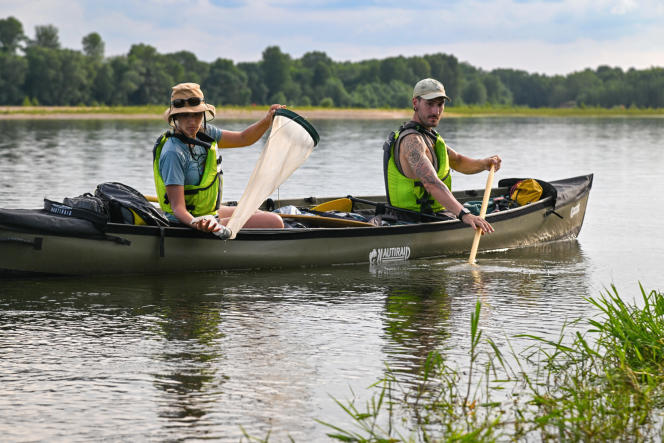They left early in the morning from Lake Issarlès, in the Ardèche, this Saturday, July 1, towards Vallon-Pont-d’Arc, a famous crossing point for summer canoeists. Barbara Réthoré (39 years old), Julien Chapuis (33 years old) and the activists of the association SOS Loire vivant did not come to hike in the department but to reveal a well-kept secret.
The couple of biologists from Maine-et-Loire and the defenders of the river intend to highlight “monumental engineering” which allows the Montpezat-sous-Bauzon hydroelectric power station to take millions of cubic meters from the Loire to power its turbines before discharging them into the Ardèche.
After studying plastic pollution and looking for traces of animal life, the two founders of the “Loire sentinel” project decided to broaden the spectrum of their research: they are now trying to understand why the river, its residents, its fauna and its flora are deprived of part of the waters, sources of life.
“It started with astonishment”
In 2022, their first phase of exploration consisted of descending the Loire by canoe. A journey of 1,000 kilometers, carried out, from May to July, from the source – a snippet that springs from Mont Gerbier-de-Jonc, in Ardèche – to the mouth, in Saint-Nazaire, in Loire-Atlantique. The couple of researchers had been struck by the anxiety-provoking spectacle of the drought and the bed of the royal river transformed in places into an immense sandbank.
“We want to try to understand what is happening in Montpezat-sous-Bauzon to bring out this file, very little known, explains Julien Chapuis. The diversion of water from the Loire to the Ardèche has a significant effect on aquatic environments and biodiversity, in a context of climate change. »
Barbara Réthoré and Julien Chapuis met at the end of the 2000s during their master’s degree in ethology (study of animal behavior in the natural environment), at the University of Rennes. Brought together by the desire to travel the world, they first rushed far, from the Makay massif, in Madagascar, to the forests of Darién, in Panama, before finding themselves nailed to their home, in Chalonnes-sur-Loire, by the Covid-19 epidemic, in the spring of 2020.
It was there, during their hour of daily outings, that they began to look at the river differently, as an object of study. “It started with astonishment, says Barbara Réthoré. We realized that no one had gone to observe the pollution of the river in microplastics. We did not know the state of contamination. » It is from this astonishment that the “Loire sentinel” project was born.
You have 53.23% of this article left to read. The following is for subscribers only.
